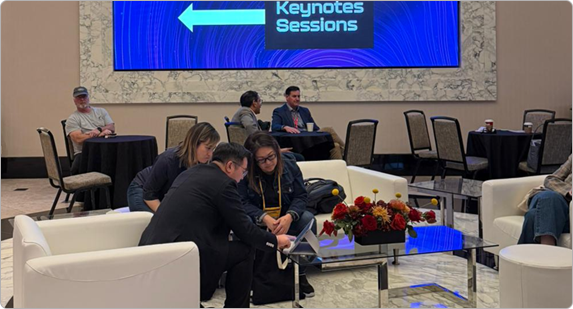Hansem Global attended DevLearn 2025 in Las Vegas to explore the latest trends shaping global learning technology. This year’s conference highlighted a major shift: learning tools are evolving from simple content-creation aids into full-scale global learning operations systems. AI-driven workflows, accessibility-by-design, learning ROI measurement, multilingual enablement, and secure data architectures are rapidly redefining how organizations create and deliver training.
In response, Hansem Global is refining its strategy to integrate our strengths in global content development and multilingual learning production into this new ecosystem—supporting clients as they modernize their learning operations and adopt scalable, AI-enabled learning transformation models.
1. AI & Automation: Moving from Content Creation to Operational Automation
The AI track at DevLearn 2025 showed a clear shift: AI is evolving from a simple content-creation tool into an end-to-end automation engine that connects planning, creation, updates, and on-the-job support. The industry is moving past experimentation toward fully implemented AI workflows.
While full lifecycle automation isn’t realistic immediately, organizations can begin by automating repetitive, high-volume tasks to gain quick, meaningful impact.
Practical starting points include:
- auto-generating drafts, quizzes, and examples for structured programs (onboarding, SOP, regulatory/safety training),
- converting post-training field Q&A into chatbot-based performance support, and
- modularizing multilingual content so it can be expanded through AI translation and connected QA workflows.
These incremental steps allow organizations to feel the impact of AI without major operational disruption.
2. Instructional Design Innovation: Making Accessibility and Learner-Centered Design the Default
The Instructional Design track positioned accessibility not as an add-on, but as a baseline requirement for modern learning design. UDL principles, scenario-based learning, learner-context consideration, and interactive formats were discussed from a very hands-on perspective.
For organizations, the key message was to start by examining the real environments in which learners access training. When learners include field technicians, service engineers, or staff across global branches, the learning experience must be designed accordingly.
Effective approaches include:
- restructuring feature-based content into scenario-driven sequences (problem–judgment–action–outcome),
- embedding accessibility elements directly from the storyboard stage (captions, alt text, color contrast, mobile readability), and
- simplifying expression and strengthening visual communication for global audiences.
Accessibility is not just about compliance; it is a design capability that directly improves learning outcomes.
3. Leadership & Strategy: Reframing the Role of Learning Around Performance Impact
The central theme of the Leadership & Strategy track was a shift from “How much training did we deliver?” to “How did training change organizational performance?”
Speakers repeatedly stressed that if L&D does not directly support transformation and KPI achievement, sustained investment becomes difficult.
To align training with measurable business outcomes, organizations should evaluate each learning asset by asking:
- What specific work behavior is this training intended to change?
- How does that behavior connect to actual KPIs such as safety incident reduction, quality improvement, rework reduction, CS resolution time, or sales conversion?
- Is the training cycle synchronized with product releases, policy changes, or regulatory requirements?
When these questions have clear answers, learning materials stop functioning as one-off events and instead become part of a continuous operational system that drives performance.

4. Learning Platforms: Evolving Toward Integration, Scalability, and Security
The Learning Platforms track focused less on adding new features and more on building integrated learning ecosystems that connect AI, data, and content repositories. For global organizations, three issues consistently emerged as top priorities: scalability, multilingual operations, and security/permission management.
Companies were encouraged to assess whether:
- their training source materials are seamlessly connected to the platform,
- multilingual courses are generated from a single-source, multi-derivative model rather than managed separately for each language, and
- learning data is stored and governed according to privacy and regulatory requirements.
Modern learning platforms are shifting from stand-alone LMS tools to becoming enterprise-wide learning infrastructure that supports global consistency, scalability, and compliance.
5. Microlearning & Immersive Learning: Strengthening Learning in the Flow of Work
Short, practical microlearning modules; AR/VR/XR simulations; gamified training; and workflow-embedded learning all received significant attention this year. These approaches allow learners to access the exact knowledge they need—often in 3–7-minute modules at the moment of need—or repeatedly practice high-risk, high-complexity tasks in a safe virtual environment.
For organizations, the recommended approach is to:
- clearly define when learners need information during their work,
- convert long-form courses into bite-sized, on-the-job learning moments, and
- prioritize AR/VR for low-frequency, high-risk, high-cost tasks where hands-on practice is most valuable.
Microlearning is not simply about shortening content—it is about designing learning with built-in distribution paths that align directly with real work.
6. Data & Measurement: Turning Learning Impact Into Operational Metrics
DevLearn 2025 showcased a major shift in how organizations measure training effectiveness. Instead of stopping at completion rates, leading companies are connecting learning data to behavior change and operational performance, redefining learning as a measurable productivity activity.
Recommended actions for organizations include:
- selecting just 1–2 key metrics (engagement, understanding, or performance) for each core program as a starting point,
- comparing data across regions, languages, and roles to identify weak spots and set content update priorities, and
- operating learning materials in an ongoing release-and-improve model, continuously updating content based on data insights.
This shift signals a future where learning is closely tied to business KPIs and becomes a critical lever for improving organizational outcomes.
Conclusion: The Future of Global Learning—and What Korean Companies Should Begin Doing Now
DevLearn 2025 presented a clear vision for the future of learning: organizations are shifting away from simply adding new tools and moving toward learning operations systems built on standardized content, supported by AI-driven workflows and data-enabled continuous improvement.
However, directly applying this model in Korea can be challenging. Many companies still lack foundational structures for learning content development and performance measurement. This means that the path forward is not about making a dramatic leap, but about building capability through a step-by-step transformation.

A realistic approach is to begin by standardizing the structure and criteria of core, repetitive training areas; redesigning content into modular components for easier reuse and updates; and then gradually integrating AI-assisted content creation, multilingual expansion, automated QA workflows, and data-driven improvement cycles.
Hansem Global will draw on the insights from DevLearn while helping Korean companies design and implement a practical, staged transformation model tailored to their environment, maturity level, and learning goals. Our commitment is to support organizations in building a robust learning content ecosystem that evolves into a scalable global learning operation.






